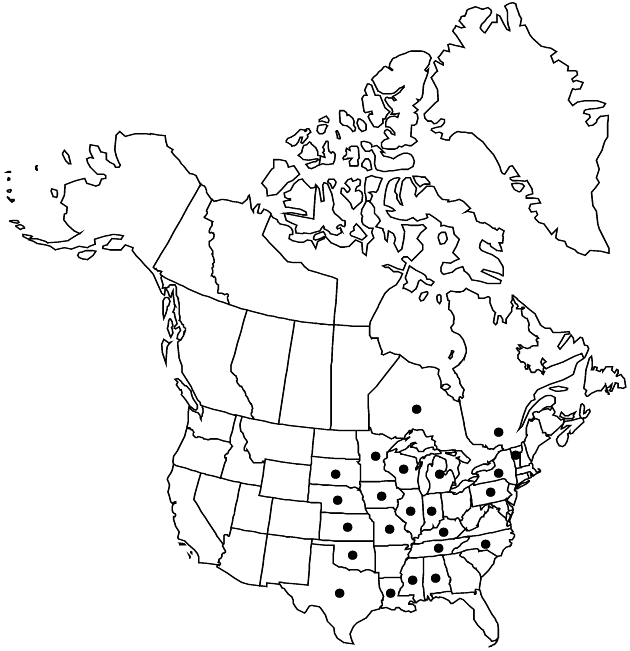Symphyotrichum ontarionis
Phytologia 77: 287. 1995.
Perennials, 20–120 cm, colonial; long-rhizomatous. Stems 1– (2–3), ascending to erect (straight), proximally glabrate, distally uniformly villous or hirsute, or glabrous (var. glabratum). Leaves thin, margins scabrous, apices mucronate, abaxial faces usually sparsely to densely strigose or strigillose, sometimes glabrous (var. glabrum), adaxial usually strigose or scabrous, sometimes glabrate or glabrous (var. glabrum); basal withering by flowering, petiolate to subpetiolate (petioles narrowly winged, ciliate, bases sheathing), blades spatulate to oblanceolate-obovate, 10–40 × 5–10 mm, bases attenuate, margins crenate-serrate, apices acute to rounded; proximalmost cauline usually withering by flowering, petiolate or sessile (petioles narrowly winged, ± clasping), blades ovate or lanceovate to elliptic-lanceolate or oblanceolate, 20–80 (–12) × 5–35 mm, progressively reduced distally, bases attenuate to cuneate, margins serrate (sometimes coarsely) to crenate-serrate, apices acute to acuminate or short-caudate; distal sessile, blades elliptic-lanceolate to oblanceolate or lanceolate, (6–) 10–80+ × 2–25 mm, progressively reduced distally, bases cuneate, margins entire to serrulate, apices acute to acuminate. Heads in ample, open, paniculiform arrays, branches ± ascending or divaricate to long-arching, ± secund. Peduncles subsessile or 2–10 (–20) mm, ± pilose, bracts 1–5, linear-lanceolate, pilose, grading into phyllaries. Involucres campanulate, 3–5.5 mm. Phyllaries in (3–) 4–6 series, unequal, appressed or ± spreading, linear-obovate (outer) to oblong-lanceolate to linear (inner), bases indurate 1/3–3/4, margins narrowly scarious to apices, erose, hyaline, ciliate, green zones lanceolate, apices acute to acuminate, mucronulate, faces (outer) sparsely pilose or glabrous (var. glabratum), (inner) glabrous. Ray-florets (10–) 15–26; corollas usually white, rarely pinkish or light purple to blue, laminae 3.5–5.5 (–8) × 0.5–1.5 mm. Disc-florets 12–25; corollas cream or light yellow turning magenta or purple (ampliate), 2.5–4 (–4.5) mm, tubes shorter than funnelform throats, lobes slightly spreading to reflexed, lanceolate, 0.7–1.1 mm. Cypselae gray or tan, oblong-obovoid, sometimes ± compressed, 1.2–1.8 (–2) mm, 3–5-nerved, faces strigillose; pappi whitish to white, 3–3.5 mm.
Distribution

Ont., Que., Ala., Ill., Ind., Iowa, Kans., Ky., La., Mich., Minn., Miss., Mo., N.C., N.Y., Nebr., Okla., Pa., S.Dak., Tenn., Tex., Vt., Wis.
Discussion
Varieties 2 (2 in the flora).
Symphyotrichum ontarionis is often confused with S. lateriflorum, from which it can be distinguished by its shorter disc corolla lobes and abaxial leaf faces either moderately to densely hairy or glabrous to glabrate (var. glabratum), and without hairs along midveins (as is typical of S. lateriflorum).
Selected References
None.
Key
| 1 | Abaxial leaf faces moderately to densely hairy | Symphyotrichum ontarionis var. ontarionis |
| 1 | Abaxial leaf faces glabrous or glabrate | Symphyotrichum ontarionis var. glabratum |
"thin" is not a number.